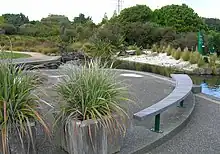Manurewa
Manurewa is a major suburb in South Auckland, New Zealand, located 6 km (3.7 mi) south of Manukau Central, and 26 km (16 mi) southeast of the Auckland City Centre. It is home to the Auckland Botanic Gardens, which receives over a million visitors a year. Manurewa has a high proportion of non-European ethnicities, making it one of the most multi-cultural suburbs in New Zealand. Employment for many is at the many companies of nearby Wiri, Papakura, and at the steel mill at Glenbrook.
Manurewa | |
|---|---|
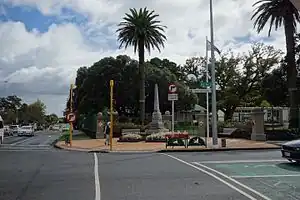 The Manurewa First World War Memorial | |
| Country | New Zealand |
| City | Auckland |
| Local authority | Auckland Council |
| Electoral ward | Manurewa-Papakura ward |
| Local board | Manurewa Local Board |
| Area | |
| • Land | 530 ha (1,310 acres) |
| Population (June 2023)[2] | |
| • Total | 19,120 |
| Train station(s) | Manurewa Train Station |
| Homai | Hillpark, Manukau Central | Manurewa East |
| Clendon Park |
|
Randwick Park |
| Weymouth | Wattle Downs | Takanini |
The area has been inhabited since at least the 13th century, and has cultural significance for Ngāti Te Ata Waiohua. Manurewa developed as a rural community after the Manurewa railway station opened in 1875, becoming a borough in 1937. The area saw major suburban growth in the 1950s and 1960s, and became a shopping hub when Southmall Manurewa opened in 1967.
Etymology
The name Manurewa is a variant of the Māori word for "kite", manu aute, used by in local Waiohua dialect.[3] The translation "soaring bird" gained popularity in the 1920s among English speakers.[4] The name is a shortened form of Te Manurewa o Tamapahore ("The Drifted-away Kite of Tamapahore"), a name which recalls a story involving Waiohua ancestor Tamapahore. One day the men who lived at Matukutūruru and Matukutūreia decided to fly kites, and Tamapahore's was the kite that flew the highest. His brother Tamapahure caused the chord of Tamapahore's kite to break. Tamapahore left the area in search of his valuable kite, eventually finding it at Whenuakite on the Coromandel Peninsula.[5][6]
Geography
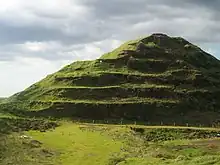
Manurewa is located in South Auckland, inland from the south-eastern Manukau Harbour, north of the Pahurehure Inlet. Manurewa is south of the Puhinui Creek,[7] and north of the Papakura Stream.[8] Manurewa is at the southern border of the Auckland volcanic field. Two volcanoes are located to the north in Wiri: Matukutūreia (also known as McLaughlins Mountain), which erupted an estimated 48,000 years ago, and Matukutūruru (Wiri Mountain), which erupted an estimated 30,000 years ago.[9] Matukutūruru was quarried, primarily by the New Zealand Railways Corporation.[10]
History
Māori history
Manurewa has been inhabited since at least the 13th century.[10] Matukutūreia and Matukutūruru were home to two hilltop pā, collectively known as Matukurua.[5] The names of the mountains commemorate a story of two chiefs. The chief of Matukutūruru ("the bittern standing at ease") was captured while eel fishing. The chief of Matukutūreia ("the vigilant bittern") saved the pā and the people of Matukutūruru.[5] Over 8,000 hectares of stonefield gardens were tended by Tāmaki Māori peoples on the lower slopes of the volcanoes,[11][12] where crops such as kūmara and bracken fern root were grown.[13]
The Manurewa area was settled by Ngā Riki, who were one of the three Tāmaki Māori groups who joined together to form the Waiohua in the 17th and 18th-centuries.[14] During this time, the two pā were home to the Ngāi Huatau hapū of Waiohua,[5] settled by Huatau, daughter of Huakaiwaka.[15][3] The chief Huarangi was based at Matukutūruru with his wife Takawai of Ngāi Tahuhu. After her death, he married Kohe, a high ranking woman from Ngāti Pāoa, a union that was widely disapproved by the hapū. This dissent eventually led to a division in the family, with the children of Takawai settling at Matukutūruru, and Huarangi moving with Kohe to Matukutūreia.[5]
Around the year 1740, a conflict between Ngāti Whātua and Waiohua led to the death of paramount chief Kiwi Tāmaki, who became the major occupants of the Tāmaki isthmus and Māngere to the north.[14][16] Ngāti Whātua was significantly smaller than the Waiohua confederation and chose to focus life at Onehunga, Māngere and Ōrākei, meaning that Waiohua were able to re-establish a presence in South Auckland.[17][16]
The Manurewa area has significance for Waiohua iwi, especially Ngāti Te Ata Waiohua, who descent from Te Ata i Rehia, the daughter of Huatau who was born on Matukutūreia,[18] and Te Ākitai Waiohua.[19]
Colonial era
.jpg.webp)
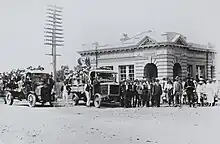
In January 1836 missionary William Thomas Fairburn brokered a land sale between Tāmaki Māori chiefs, Pōtatau Te Wherowhero and Turia of Ngāti Te Rau, covering the majority of modern-day South Auckland between Ōtāhuhu and Papakura. The sale was envisioned as a way to end hostilities in the area, but it is unclear what the chiefs understood or consented to. Māori continued to live in South Auckland, unchanged by this sale.[20] Fairburn was criticised for the sheer size of the purchase, and in 1842 the Crown significantly reduced the size of his land holdings,[13] and the Crown partitioned much of the land for European settlers.[20] 10,000 acres of the Fairburn purchase was given to James Reddy Clendon in return for land at Kororāreka / Russell where the new capital of New Zealand was established.[21] Clendon never lived or visited the area,[22] but sold 2,000 acres to the Martin brothers, who subdivided the land in the mid-1900s.[23] Much of the Martin brothers' land became modern-day Manurewa.[24]
Work on the Great South Road began in 1843, reaching as far south as Drury in 1855.[25] In the early 1860s, Great South Road was used as a military supply route between Auckland and the frontier of the Invasion of the Waikato.[26][27] Manurewa was only sparsely populated in the 1860s and 1870s. The major stop on the Great South Road for coach services was the Raglan Hotel at Woodside (modern-day Wiri). The Manurewa Highway District was formed in 1867,[28] and in 1875 the first Manurewa railway station opened.[23] The station led to growth in the area; 81 people lived in Manurewa by 1879, and a post office opened in 1884.[23] By the 1900s, much of Woodside village had moved to Manurewa, including the school that moved by 1906,[23] and joined by the Methodist Church in 1909. [23] Manurewa became a centre for the dairy industry in the early 20th century,[24] with the first creamery opening in 1905.[23]
Suburban development
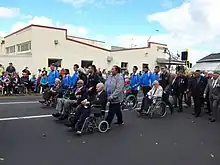
By 1915, Manurewa had grown large enough to become a town district, created from parts of the former Manurewa and Papakura road districts.[29] The area was promoted as a commuter suburb for Auckland in the early 1920s.[29] Local farmer Charles Henry Lupton was instrumental in developing the Manurewa community, serving on the town board, school and church committees, and became known as "The Father of Manurewa".[29][30] By 1937, the population of Manurewa had increased to over 1,500 people, allowing Manurewa to become a borough.[29] In 1939, a fire destroyed the Manurewa Picture Theatre, and the adjoining shops and boarding house.[30] During World War II, parts of Manurewa were used as military camps for United States Army soldiers bound for the Pacific.[31]
Manurewa experienced rapid growth in the 1950s and early 1960s after the development of the Auckland Southern Motorway,[32] developing from a semi-rural locality into a suburb of Auckland.[33] Southmall Manurewa, the third American-style mall in Auckland, was opened in 1967. The mall was initially very successful, but struggled from October 1976 onwards after the opening of the Manukau Shopping Centre.[34]
By the 1970s, Manurewa East and Weymouth had developed as suburban areas, and after the construction of Manukau Central in the 1980s, Manurewa was became connected to the urban sprawl of Auckland.[32] In 1982, the Auckland Botanic Gardens opened in Manurewa.[33]
By the 2010s, Manurewa had developed a significant Pasifika population, and had the highest proportion of Māori residents in the city.[35][36]
Demographics
Manurewa covers 5.30 km2 (2.05 sq mi)[1] and had an estimated population of 19,120 as of June 2023,[2] with a population density of 3,608 people per km2.
| Year | Pop. | ±% p.a. |
|---|---|---|
| 2006 | 15,591 | — |
| 2013 | 16,842 | +1.11% |
| 2018 | 19,236 | +2.69% |
| Source: [37] | ||
Manurewa had a population of 19,236 at the 2018 New Zealand census, an increase of 2,394 people (14.2%) since the 2013 census, and an increase of 3,645 people (23.4%) since the 2006 census. There were 4,572 households, comprising 9,765 males and 9,474 females, giving a sex ratio of 1.03 males per female, with 5,160 people (26.8%) aged under 15 years, 5,226 (27.2%) aged 15 to 29, 7,461 (38.8%) aged 30 to 64, and 1,392 (7.2%) aged 65 or older.
Ethnicities were 24.5% European/Pākehā, 30.9% Māori, 41.1% Pacific peoples, 23.0% Asian, and 2.3% other ethnicities. People may identify with more than one ethnicity.
The percentage of people born overseas was 34.9, compared with 27.1% nationally.
Although some people chose not to answer the census's question about religious affiliation, 27.3% had no religion, 46.3% were Christian, 3.8% had Māori religious beliefs, 6.7% were Hindu, 2.4% were Muslim, 1.4% were Buddhist and 6.4% had other religions.
Of those at least 15 years old, 1,494 (10.6%) people had a bachelor's or higher degree, and 3,153 (22.4%) people had no formal qualifications. 891 people (6.3%) earned over $70,000 compared to 17.2% nationally. The employment status of those at least 15 was that 6,927 (49.2%) people were employed full-time, 1,515 (10.8%) were part-time, and 996 (7.1%) were unemployed.[37]
| Name | Area (km2) | Population | Density (per km2) | Households | Median age | Median income |
|---|---|---|---|---|---|---|
| Rowandale West | 0.69 | 3,471 | 5,030 | 738 | 25.2 years | $22,900[38] |
| Rowandale East | 0.83 | 3,813 | 4,594 | 828 | 27.0 years | $26,600[39] |
| Manurewa Central | 1.07 | 3,678 | 3,437 | 948 | 29.5 years | $26,800[40] |
| Leabank | 1.49 | 4,350 | 2,919 | 1,047 | 28.0 years | $24,200[41] |
| Manurewa South | 1.22 | 3,924 | 3,216 | 1,011 | 28.6 years | $25,600[42] |
| New Zealand | 37.4 years | $31,800 |
Sport and recreation
Rugby union
The Manurewa Rugby Football Club is based at Mountfort Park Manurewa. They were founded in 1921 and now play within the Counties Manukau Rugby Union Club competition and are one of the biggest and most successful Rugby clubs within the region. They have a large junior section plus and string Golden Oldies Section made up of many past players. They also have associated sports of AFL, Netball & Softball operating within the club. They were originally based at Jellicoe Park in Manurewa and had a club room affectionately known as the "Old Black Shed". They built the new clubrooms at Mountfort Park and moved to this site officially in 1978. Notable current Super 15 Chiefs players Tim Nanai-Williams, Viliami Taulani and Bundee Aki are former Manurewa Rugby Club players.
Association football
The football (soccer) club Manurewa AFC who play in the Lotto Sport Italia NRFL Division 1A are based in Manurewa.
Rugby league
The Manurewa Marlins are based in Manurewa.
Local government
The first local government in the area was the Manurewa Highway District, which formed in 1867 to administer road upkeep.[28] By 1915, Manurewa had grown large enough to become a town district within the Manukau County, and by 1937 it had become a borough.[30] On 3 September 1965, the Manukau County and Manurewa Borough merged to form Manukau City.[28] In November 2010, all cities and districts of the Auckland Region were amalgamated into a single body, governed by the Auckland Council.[43]
Manurewa is a part of the Manurewa local board area. The residents of Manurewa elect a local board, and two councillors from the Manurewa-Papakura ward to sit on the Auckland Council.
Chairmen of the Manurewa Town Board
Below is a list of the six people who served as the chairman of the Manurewa Town Board.[44]
- 1916–1918 Thomas James Corin
- 1918–1920 Charles Henry Lupton
- 1920–1922 Thomas James Corin
- 1922–1928 Arthur Clifton Axford Sexton
- 1928–1930 George Gallaher
- 1930–1932 William Johnston Ferguson
- 1932–1937 William Thomas Cox
Mayors during Manurewa Borough Council
Below is a list of the six people who served as the mayor of the Manurewa Borough Council.[45]
- 1937–1944 William Johnston Ferguson
- 1944–1946 Frederick Herny Barnard
- 1946–1948 John Augusta Kelly
- 1948–1953 Reginald Frank Judson
- 1953–1956 Cecil Millington Crawford
- 1956–1965 Harry Beaumont
Amenities and attractions
- Auckland Botanic Gardens
- Jellicoe Park, home to Manurewa Amateur Athletics & Harriers Club and Jellicoe Park Tennis Club
- Gallaher Park, home to the Manurewa Scout Hall, Gallaher Park Touch and Alfriston Road Playcentre
- Manurewa Pool and Leisure Centre
- Manurewa Marae in Clendon Park
- Southmall Manurewa, and the surrounding Manurewa town centre.
- Te Pae Maumahara / Manurewa War Memorial Park, home to Manurewa AFC and the Homai Bowling Club
Religion

- Baitul Muqeet Mosque, an Ahmadi Muslim mosque that was built in 2013.[46]
- Manurewa Methodist Church, which moved from Witi to Manurewa in 1909.[47]
- The Manurewa Nanaksar gurdwara, a large Sikh temple.[48]
- St Andrews Presbyterian Church, established in 1927.[49]
- St Anne's Catholic Church, established in 1927.[49]
- St Lukes Anglican Church, which was established in 1910.[49]
- Wat Khemaraphirataram, a Cambodian Buddhist temple that opened in 2018.[50]
Education
The first school in Manurewa was the Manurewa Central School, which began as the Woodhill School in Wiri, and was moved in 1906.[23]
James Cook High School is a secondary school (years 9–13) with a roll of 1407.[51]
Manurewa Intermediate is an intermediate school (years 7–8) with a roll of 912.[52]
Finlayson Park School, Leabank School. Manurewa Central School, Manurewa South School, Manurewa West School and Rowandale School are contributing primary schools (years 1–6) with rolls of 890, 371, 477, 363, 407 and 593 students, respectively.[53][54][55][56][57][58] In 2020 Finlayson Park School in Auckland became the first school in New Zealand to set up a Kiribati language unit, where Erika Taeang was employed as the teacher.[59][60]
St Anne's Catholic School is a state-integrated full primary school (years 1–8) with a roll of 519.[61] Notable alumni includes libertarian politician Stephen Berry.[62]
Manukau Christian School is a private composite school (years 1–13) with a roll of 282.[63]
All these schools are coeducational. Rolls are as of April 2023.[64]
Notable people
- Decepticonz, hip hop group[65]
- Stephen Berry (born 1983), politician and political commentator[66]
- Jawsh 685 (born 2002), musician[67]
- Erika Taeang, teacher
References
- "ArcGIS Web Application". statsnz.maps.arcgis.com. Retrieved 15 August 2022.
- "Population estimate tables - NZ.Stat". Statistics New Zealand. Retrieved 25 October 2023.
- Marshall-Harding, Kerry; Tuiono, Teariki (22 November 2021). Te Manurewa o Tamapahore. Ono Ariki Solutions. ISBN 9780473594176.
- Wichman, Gwen 2001, pp. 9.
- "Tales of Manurewa: Nga Matukurua - The Two Bitterns". Manurewa Marae. Retrieved 30 March 2023.
- "Manurewa". New Zealand Gazetteer. Land Information New Zealand. Retrieved 30 March 2023.
- "Puhinui Creek". New Zealand Gazetteer. Land Information New Zealand. Retrieved 30 March 2023.
- "Papakura Stream". New Zealand Gazetteer. Land Information New Zealand. Retrieved 30 March 2023.
- Hopkins, Jenni L.; Smid, Elaine R.; Eccles, Jennifer D.; Hayes, Josh L.; Hayward, Bruce W.; McGee, Lucy E.; van Wijk, Kasper; Wilson, Thomas M.; Cronin, Shane J.; Leonard, Graham S.; Lindsay, Jan M.; Németh, Karoly; Smith, Ian E. M. (3 July 2021). "Auckland Volcanic Field magmatism, volcanism, and hazard: a review". New Zealand Journal of Geology and Geophysics. 64 (2–3): 213–234. doi:10.1080/00288306.2020.1736102. S2CID 216443777.
- Foster, Russell (1988). Archaeological Survey of the Remnant of Wiri Mountain (Matukutururu), Manukau City (PDF) (Report). Regional Archaeology Unit, Auckland. Retrieved 30 March 2023.
- "Matukutūruru". Tūpuna Maunga Authority. Retrieved 30 March 2023.
- Wichman, Gwen 2001, pp. 10.
- Wichman, Gwen 1990, pp. 3.
- Taonui, Rāwiri (8 February 2005). "The tribes of Tāmaki". Te Ara. Retrieved 17 March 2021.
- Ngāti Te Ata Waiohua (December 2012). Redoubt Road – Mill Road Corridor Project Maori Values Assessment for Auckland Transport (PDF) (Report). Auckland Transport. Retrieved 30 March 2023.
- Patterson, Malcolm (21 March 2008). "Ngati Whatua o Orakei Heritage Report for State Highway 20; Transit Manukau Harbour Crossing" (PDF). Environmental Protection Authority. pp. 6–7. Retrieved 21 October 2021.
- "ca 1765". Manukau's Journey. Auckland Libraries. Retrieved 30 March 2023.
- "ca 1680". Manukau's Journey. Auckland Libraries. Retrieved 30 March 2023.
- "Te Ākitai Waiohua". Te Kāhui Māngai (Directory of Iwi and Māori Organisations). Te Puni Kōkiri. Retrieved 30 March 2023.
- Moore, D; Rigby, B; Russell, M (July 1997). Rangahaua Whanui National Theme A: Old Land Claims (PDF) (Report). Waitangi Tribunal. Retrieved 5 March 2023.
- Lee, Jack (February 2014). "Clendon, James Reddy". Te Ara: The Encyclopedia of New Zealand. Retrieved 30 March 2023.
- "18 October 1842". Manukau's Journey. Auckland Libraries. Retrieved 30 March 2023.
- Wichman, Gwen 1990, pp. 4.
- Wichman, Gwen 2001, pp. 11.
- "Papatoetoe Heritage Trail" (PDF). Ōtara-Papatoetoe Local Board. 2013. Retrieved 31 March 2023.
- O'Malley, Vincent (6 December 2016). "'The great war for NZ broke out less than 50 km from Queen St': Vincent O'Malley on the Waikato War and the making of Auckland". The Spinoff. Retrieved 30 March 2023.
- Prickett, Nigel (2003). "The History and Archaeology of Queen's Redoubt, South Auckland". Records of the Auckland Museum. 40: 5–37. ISSN 1174-9202. JSTOR 42905861. Wikidata Q58623334.
- Bloomfield, G.T. (1973). The Evolution of Local Government Areas in Metropolitan Auckland, 1840–1971. Auckland University Press, Oxford University Press. pp. 56–57, 110, 122. ISBN 0 19 647714 X.
- Wichman, Gwen 2001, pp. 17.
- Wichman, Gwen 1990, pp. 5.
- "12 June 1942". Manukau's Journey. Auckland Libraries. Retrieved 30 March 2023.
- "A brief history of Auckland's urban form" (PDF). Auckland Regional Council. April 2010. Retrieved 4 April 2023.
- McClure, Margaret (5 August 2016). "Auckland places - South Auckland". Te Ara: The Encyclopedia of New Zealand. Retrieved 30 March 2023.
- "Southmall". Auckland Libraries. Retrieved 30 March 2023.
- Ethnicity and Migration in Auckland (PDF) (Report). Auckland Council. February 2013. ISBN 978-1-927216-34-7. Retrieved 4 April 2023.
- Te Pūrongo a Te Kaunihera o Tāmaki Makaurau Ngā Huanga Māori 2021/2022. Auckland Council Group Māori Outcomes Report 2021/2022 (PDF) (Report). Auckland Council. November 2022. Retrieved 30 March 2023.
- "Statistical area 1 dataset for 2018 Census". Statistics New Zealand. March 2020. Rowandale West (159900), Rowandale East (160000), Manurewa Central (160100), Leabank (160600) and Manurewa South (160900).
- 2018 Census place summary: Rowandale West
- 2018 Census place summary: Rowandale East
- 2018 Census place summary: Manurewa Central
- 2018 Census place summary: Leabank
- 2018 Census place summary: Manurewa South
- Blakeley, Roger (2015). "The planning framework for Auckland 'super city': an insider's view". Policy Quarterly. 11 (4). doi:10.26686/pq.v11i4.4572. ISSN 2324-1101.
- Wichman, Gwen 2001, pp. 155–158.
- Wichman, Gwen 2001, pp. 159–162.
- Morgan, Scott (31 October 2013). "Prayers for opening". Stuff.
- Mangnall, Karen (8 April 2009). "Church to celebrate centenary". Stuff. Retrieved 5 April 2023.
- Kilgallon, Steve (3 August 2021). "Investigation as migrants complain about treatment by wealthy temple". Stuff. Retrieved 5 April 2023.
- Wichman, Gwen 1990, pp. 6.
- "2 February 2018". Kura. Auckland Libraries. Retrieved 5 April 2023.
- Education Counts: James Cook High School
- Education Counts: Manurewa Intermediate
- Education Counts: Finlayson Park School
- Education Counts: Leabank School
- Education Counts: Manurewa Central School
- Education Counts: Manurewa South School
- Education Counts: Manurewa West School
- Education Counts: Rowandale School
- "Auckland school establishes Kiribati language unit | RNZ". Radio New Zealand. 8 October 2021. Archived from the original on 8 October 2021. Retrieved 8 October 2021.
- "Kiribati / Pacific languages / Home - Pasifika". 8 October 2021. Archived from the original on 8 October 2021. Retrieved 8 October 2021.
- Education Counts: St Anne's Catholic School
- Berry, Stephen (21 September 2019). "Manurewa-Papakura Ward: An Absolutely Biased Guide to Auckland Local Elections". The BFD. Retrieved 4 April 2021.
- Education Counts: Manukau Christian School
- "New Zealand Schools Directory". New Zealand Ministry of Education. Retrieved 12 December 2022.
- "April 2002". Manukau's Journey. Auckland Libraries. Retrieved 30 March 2023.
- Berry, Stephen (21 September 2019). "Manurewa-Papakura Ward: An Absolutely Biased Guide to Auckland Local Elections". The BFD. Retrieved 22 March 2021.
- "WATCH: Auckland teen Jawsh 685 is #1 on the iTunes chart". RNZ. 26 June 2020. Retrieved 12 July 2020.
Bibliography
- Wichman, Gwen (1990), A brief history of Manurewa, Manurewa: Manurewa Historical Society, Wikidata Q117327773
- Wichman, Gwen (2001). Soaring Bird: a History of Manurewa to 1965. Manurewa: Manurewa Historical Society. ISBN 0-473-07114-2. Wikidata Q117421984.
External links
- Photographs of Manurewa held in Auckland Libraries' heritage collections.
- Photographs of Manurewa held in Auckland War Memorial Museum heritage collections.
